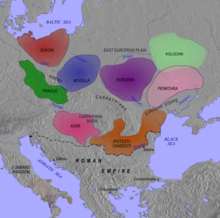Penkovka culture
Penkovka culture (English Penkovka culture ) is the name for archaeological finds from the 5th to 7th centuries in the area of today's Ukraine and Moldova . It includes different archaeological groups and is therefore controversial.
Dispersion area
The Penkovka group extended from the central Dnieper along Sula , Seim , Psel , Seversky Donets and Oril to the central Dniester and central Prut .
The culture is named after the place where it was found in Penkowka near Vinnitsa . About 300 sites are known in Ukraine. Fortified larger settlements existed at Pastyrske (political center) and Seliste .
The Penkovka culture bordered on the east by the Saltovo-Mayaki culture , to the north by the Kolotschin culture and to the west by the Kortschak group .
Origin and cultural classification
The Penkovka culture emerged in the 5th century from the Chernyakhov culture and the Kiev culture with Iranian and Turkic influences.
The bearers of the Penkowka culture were multiethnic. The material culture was on the one hand Slavic, it did not differ from the simultaneous Prague-Korchak culture , especially in ceramics. On the other hand, there were also strong nomadic elements, for example in metalworking and in the settlements (yurts). It is therefore difficult to make clear cultural classifications for the entire settlement area. Different ethnic groups probably lived side by side and influenced each other.
In the written sources of this time in mentioned for the area of the ruling association of the Anten . It is methodologically difficult to assign these directly to the Penkowka culture. Russian, Ukrainian and Bulgarian archaeological research assume such an assignment.
economy
Agriculture and animal husbandry, some of them nomadic, were the basis of life. The metalworking showed Khazarian, Caucasian, Byzantine, Arab and Baltic influences. A metalworking center was found at Gajworon on the Southern Bug . A larger find of 116 silver objects shows mainly eastern nomadic influences.
The handmade pottery was very close to the Prague culture . Pottery from the eastern Saltovo-Mayak culture ( Khazars ), known as Saltovo or Pastyrske ceramics , was also widespread .
Settlements
The settlements were on rivers and were not fortified. The area was mostly no more than 2 or 3 hectares. The settlements consisted of up to 30 houses, of which only 12-15 were used at the same time. After a while they were abandoned and later inhabited again.
The houses were sunk into the earth (0.6–0.8 m), mostly rectangular, rarely oval. The doors faced south or east.
Funeral culture
There were cremations in the forest steppe areas. The burial places were in lowlands and were 0.5 to 1 km away from the settlements. The dead were cremated at the burial sites and buried in graves with or without urns. The grave goods were sparse (jewelry).
In the open steppe zone there were also body burials with richer grave goods (weapons, objects of representation). These corresponded to the customs of the eastern cultures (Khazars, Alans, Bulgarians, Utrigurs), so it is not clear whether they can be assigned to the Penkovka culture.
Changes
The Penkowka culture ended at the beginning of the 8th century. Slavic archaeological groups followed in the area.
Web links
- Valentin Sedow, Penkovka Culture (Russian)
- Penkovka culture (overview with references and illustrations, 2014) (Russian)
literature
- Frank Kämper: Eastern Slaves . In: Lexicon of the Middle Ages (LexMA). Volume 6, Artemis & Winkler, Munich / Zurich 1993, ISBN 3-7608-8906-9 , Sp. 1546 f.
- Florin Curta: The Making of the Slavs: History and Archeology of the Lower Danube Region , Cambridge 2001
Remarks
- ↑ Bartlomiej Szymon Szmoniewski: The Antes: Eastern "Brothers" of the Sclavenes? in: Florin Curta (Ed.): Neglected Barbarians. Brepols, Turnhout 2010, here pp. 74–76
- ↑ IP Rusanowa , Славянские древности VI — VII вв first referred to nomadic influences . ( Early Slavic finds of the 6th and 7th centuries ), Moscow 1976 online ( page no longer available , search in web archives ) Info: The link was automatically marked as defective. Please check the link according to the instructions and then remove this notice. , P. 103ff., Cf. also WW Sedow , Slawjane w rannem srednewekowe , Moscow 1996 online ( memento of the original from September 19, 2007 in the Internet Archive ) Info: The archive link has been inserted automatically and has not yet been checked. Please check the original and archive link according to the instructions and then remove this notice. ; ders., Etnogenes rannych slawjan , in: Westnik RAN , vol. 73/7, 2003, p. 594ff. online , and others
- ↑ Skeptical Bartlomiej Szymon Szmoniewski: The Antes: Eastern “Brothers” of the Slavenes? in: Florin Curta (Ed.): Neglected Barbarians. Brepols, Turnhout 2010, pp. 53–82, here p. 82. Even if methodological criticism of the equation of archaeological cultures and historical ethnic groups were disregarded, the area of the Penkowka culture would be far too large to be even remotely covered by the Anten could have been taken.
